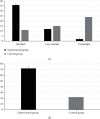Effect of Algoplaque Hydrocolloid Dressing Combined with Nanosilver Antibacterial Gel under Predictive Nursing in the Treatment of Medical Device-Related Pressure Injury
- PMID: 35860183
- PMCID: PMC9293497
- DOI: 10.1155/2022/9756602
Effect of Algoplaque Hydrocolloid Dressing Combined with Nanosilver Antibacterial Gel under Predictive Nursing in the Treatment of Medical Device-Related Pressure Injury
Abstract
It was aimed at the clinical value of predictive nursing and Algoplaque hydrocolloid dressing (AHD) combined with nanosilver antibacterial gel in treating medical device-related pressure injury (MDRPI). 100 patients, who underwent surgery in Chongqing Qijiang District People's Hospital from February 2019 to February 2020, were selected as the research objects and were randomly divided into the experimental group (50 cases) and the control group (50 cases). For the characterization test, a nanosilver antibacterial gel was created first. Patients in both groups received predictive nursing, but those in the experimental group received AHD and nanosilver antibacterial gel, and those in the control group received gauzes. MDRPI incidence, pressed skin injury severity, comfort level, clothing changes, nursing satisfaction, and other factors were all compared. The particle size of the nanosilver gel was 45-85 nm, with a relatively homogeneous distribution with the medium size, according to the findings. The incidence of MDRPI in the experimental group was lower than that in the control group significantly (6% vs. 30%, P < 0.05). The degree of injury of pressured skin in the experimental group was milder than that in the control group (P < 0.05), the degree of comfort and nursing satisfaction was higher in the experimental group than in the control group (P < 0.05), and dressing change count was lower than that in the control group (P < 0.05). In the treatment of MDRPI, predictive nursing and AHD using nanosilver antibacterial gel showed high clinical application value.
Copyright © 2022 Chunxiu Li et al.
Conflict of interest statement
The authors declare that they have no conflicts of interest.
Figures





Similar articles
-
Effectiveness of using hydrocolloid dressing combined with 3M Cavilon No-Sting Barrier Film to prevent facial pressure injury on medical staff in a COVID-19 designated hospital in China: a self-controlled study.Ann Palliat Med. 2021 Jan;10(1):3-9. doi: 10.21037/apm-20-1615. Epub 2021 Jan 18. Ann Palliat Med. 2021. PMID: 33474960
-
Investigating the Efficacy of Hydrocolloid Dressing for Preventing Nasotracheal Tube-Related Pressure Injury in the PICU.Pediatr Crit Care Med. 2020 Sep;21(9):e752-e758. doi: 10.1097/PCC.0000000000002494. Pediatr Crit Care Med. 2020. PMID: 32740180 Clinical Trial.
-
Effects of Silicone Mattress Combined with Hydrocolloid Dressing on Pressure Ulcers and Phlebitis in ICU Patients with Liver Failure.Comput Math Methods Med. 2022 Apr 15;2022:7828650. doi: 10.1155/2022/7828650. eCollection 2022. Comput Math Methods Med. 2022. Retraction in: Comput Math Methods Med. 2023 Jul 19;2023:9874815. doi: 10.1155/2023/9874815. PMID: 35465000 Free PMC article. Retracted.
-
Use of a Hydrocolloid Dressing in the Prevention of Device-related Pressure Ulcers During Noninvasive Ventilation: A Meta-analysis of Randomized Controlled Trials.Wound Manag Prev. 2019 Feb;65(2):30-38. Wound Manag Prev. 2019. PMID: 30730303
-
Effectiveness of Hydrocolloid Dressings for Treating Pressure Ulcers in Adult Patients: A Systematic Review and Meta-Analysis.Int J Environ Res Public Health. 2020 Oct 27;17(21):7881. doi: 10.3390/ijerph17217881. Int J Environ Res Public Health. 2020. PMID: 33121151 Free PMC article.
References
-
- Lustig A., Margi R., Orlov A., Orlova D., Azaria L., Gefen A. The mechanobiology theory of the development of medical device-related pressure ulcers revealed through a cell-scale computational modeling framework. Biomechanics and Modeling in Mechanobiology . 2021;20(3):851–860. doi: 10.1007/s10237-021-01432-w. - DOI - PMC - PubMed
Publication types
MeSH terms
Substances
LinkOut - more resources
Full Text Sources
Medical

